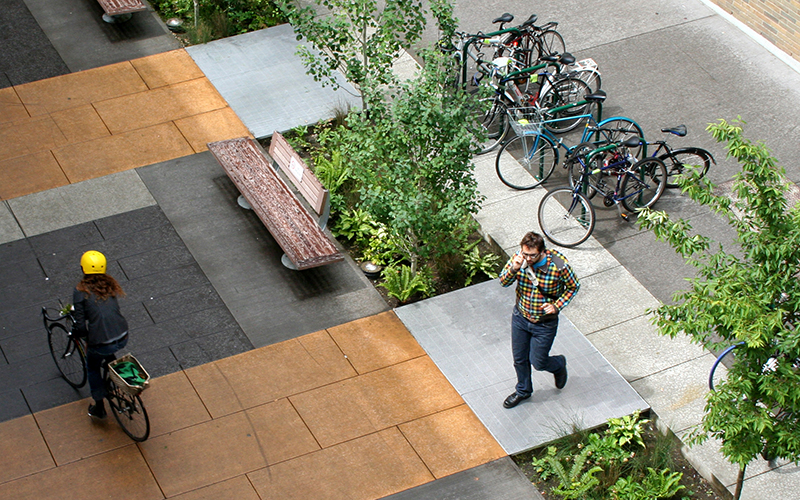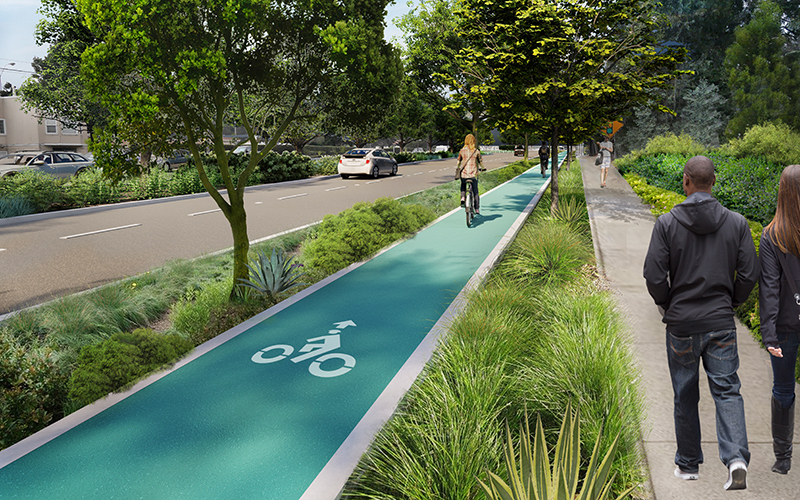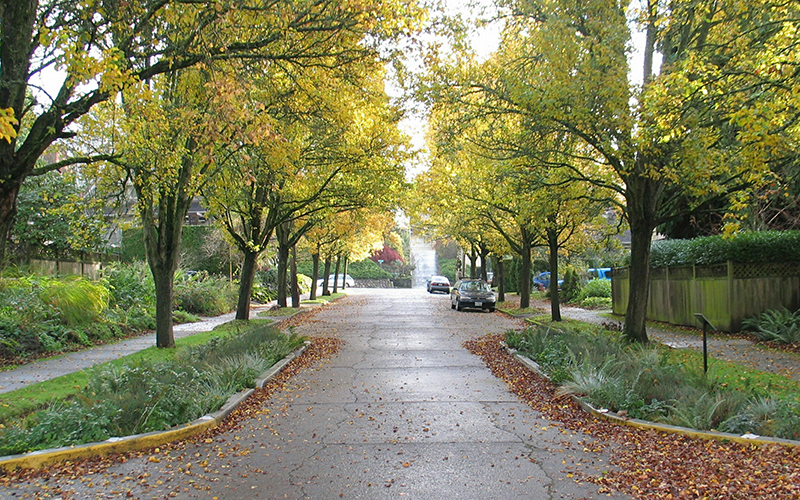 Kevin Robert Perry, FASLA
Kevin Robert Perry, FASLA
Kevin Robert Perry, FASLA
Senior Landscape Architect, Toole Design, and Principal, Urban Rain Design
Thank you Chair Napolitano, Ranking Member Rouzer, and Members of the subcommittee for the opportunity to testify on the valuable work being done by landscape architects in the water and stormwater management space.
My name is Kevin Robert Perry and I am a licensed landscape architect and an internationally recognized leader in successfully integrating stormwater management with high-quality urban design.
I work as a Senior Landscape Architect at Toole Design Group with a specific expertise in intertwining green infrastructure with innovative multimodal streetscape design. I am also the founder of Urban Rain Design, a small design studio based in both California and Oregon that specializes in using Tactical Green Infrastructure to rapidly implement simple, cost-effective, and beautiful public space stormwater projects.
I am here today on behalf of the American Society of Landscape Architects (ASLA), where I have been a Fellow since 2017.
ASLA believes that water quality is essential to our economy, communities, and environment. By working to protect it, our membership of landscape architects plays a critical role in community sustainability and public health.
Landscape architects address water quality through ecologically-based practices that help reduce or remove pollutants in urban, rural, and conservation areas. To help protect water quality and conserve valuable water resources, ASLA encourages planning, design management, and policies that are science-based, collaborative, creative, and equitable.
The Value of Green Infrastructure
Ample clean water supplies are necessary to help preserve health, sustain quality of life, support economic stability, and maintain environmental quality.
Unsustainable development practices, poorly designed infrastructure, population growth, and other factors continue to threaten water quality and emphasize the need for the wiser and more creative use of resources. Urban sprawl and the expansion of paved surfaces increases volume and speed of storm flows, carries pollutants into streams, prevents groundwater recharge, and drastically reduces the landscape’s ability to respond to everyday storm events, much less the current and future challenges of climate change.
In much of the country, especially in older cities and towns, stormwater is funneled into our wastewater systems. During intense rain events, these systems can become overwhelmed resulting in stormwater overflow being released into nearby waters -- along with all of the untreated sewage, debris, pesticides, and anything else caught in the underground pipe system.
While the United States has generally had success in protecting water quality, EPA research has found that nonpoint source pollution, the type of water pollution I just described, remains the leading cause of water quality problems.
This is where landscape architects are stepping up and playing a key role. We are at the forefront of developing innovative design strategies that promote sustainability, resiliency, and a balanced vibrancy between our built and natural environment. By incorporating cost-effective and innovative green infrastructure methods into our projects, we plan and design landscaped-based systems that reduce the impacts of flooding, contain the movement of pollutants and other debris, help infiltrate stormwater on-site, increase biodiversity, and integrate these nature-based solutions seamlessly into our cities and towns.
 SW Montgomery Green Street, Portland, Oregon / Kevin Robert Perry
SW Montgomery Green Street, Portland, Oregon / Kevin Robert Perry
In areas where drought and inadequate water supply is of top concern, green infrastructure may also be a viable solution, helping to replenish local groundwater reserves and recharging aquifers. We also promote and incorporate the use of sustainably-designed greywater systems and other water capture measures to help reduce the need for external water sources.
In general, the landscape architect’s multi-functional, multi-purpose design solutions allows for a less destructive human relationship with the natural environment.
Landscape architecture practices also provide a key equity and environmental justice solution. One such practice is performing meaningful community engagement during the design and planning process. Often, the communities that stand to benefit the most from our work are the low-income and racially diverse communities that have been damaged by years of underinvestment and disinvestment. This includes communities located in small towns, large cities, and all areas in between. ASLA and its members are committed to utilizing our trade to directly improve lives in underserved communities; and community engagement and green infrastructure can be important tools to aid in this effort.
 Planned Green Street Improvements in Colma, California / Kevin Robert Perry
Planned Green Street Improvements in Colma, California / Kevin Robert Perry
Green infrastructure also leads to job creation. According to Green For All, a national organization working to build an inclusive green economy, a $188.4 billion investment in stormwater management would generate $265.6 billion in economic activity and create close to 1.9 million jobs. Furthermore, green infrastructure is good for small businesses, as many landscape architects work for or run their own small firms, as I have for nearly a decade.
Green Infrastructure Across Scales
One of the greatest benefits of using green infrastructure is that it can be implemented across a wide range of scale and community contexts. Resilient coastlines/riverfronts, regional parks, and interconnected green transportation corridors can be realized at the large citywide-scale; while rain gardens, pervious paving, and a robust use of street trees can grace nearly any neighborhood-scale space.
 ASLA 2007 Professional General Design Honor Award. NE Siskiyou Green Street, Portland, Oregon / Kevin Robert Perry
ASLA 2007 Professional General Design Honor Award. NE Siskiyou Green Street, Portland, Oregon / Kevin Robert Perry With thousands of our schools, roads, parks, and other civic space infrastructure either breaking down or inefficiently designed, there is an incredible opportunity to boldly retrofit our built environment with long-lasting green infrastructure strategies.
Tactical Green Infrastructure
One avenue of green infrastructure that is starting to take root on the West Coast is the concept of Tactical Green Infrastructure. While many infrastructure projects can take years to be fully implemented, Tactical Green Infrastructure is a specialized design-build methodology that allows professional design practitioners, students, and/or volunteers to work together to identify, design, and construct expedited green infrastructure projects at public schools, parks, and even some street locations. These small-scale projects convert either existing paved or underutilized green space into highly functional rain garden landscapes within a couple of months – and directly involve the local community through the process. This kind of low-cost, effective, and quickly built Green Infrastructure can be a simple national model but with near-term and tangible results realized at the neighborhood level. While conceived in both Oregon and California, we believe a coordinated Tactical Green Infrastructure approach, led by landscape architects, has immense potential to expand throughout the United States.
The Water Quality Protection and Job Creation Act of 2021
ASLA and its members appreciate the committee’s support for legislation promoting green infrastructure, including H.R. 1915 – the Water Quality Protection and Job Creation Act of 2021, which would help states and local communities fund green infrastructure projects that protect water.
We are also appreciative of the committee’s support for the Clean Water State Revolving Fund, and specifically the Green Project Reserve, which mandates that at least 10% of funds are used by states for green infrastructure projects. Since states and localities typically do not have their own funding mechanisms to keep their water infrastructure safe, up to date, and within the requirements of the Clean Water Act, many landscape architecture projects would not be possible without the help of this program.
For these reasons, ASLA is supportive of increased funding to the Clean Water SRF, as well as making the Green Project Reserve permanent and increasing its minimum percentage. To make projects even more sustainable and resilient, the Clean Water SRF should also be adjusted to allow for the funding of long-term maintenance projects as well.
Conclusion
With that, I thank the committee for inviting me to testify today. ASLA looks forward to working with you and your colleagues to ensure that Congress leverages the field of landscape architecture when striving for its climate adaptation and sustainability goals.